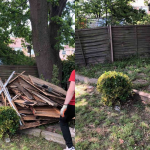When the chill of winter sets in, there’s nothing quite like cozying up by a fireplace, relaxing in the warm glow of crackling flames. But what if you could enjoy that same ambiance without the need for a functional chimney or the complexities of a real fire? Meet the faux fireplace and discover how it can cozy up your living room in a few simple steps.

What is a faux fireplace?
A faux fireplace, short for “false fireplace,” is a decorative fireplace that mimics the look of a traditional wood-burning or gas fireplace. It adds charm and coziness without the mess of a conventional fireplace.
A faux fireplace uses artificial methods to create the illusion of a burning fire. They come in many shapes and sizes to make it easy for you to choose the one that fits best with your home decor. Many faux fireplace models use electric or LED technology to create lifelike flames. Some even offer adjustable settings to control the flame’s intensity and appearance.
If you’re a DIY fan, you’ll be glad to discover that a faux fireplace is simple to install without needing a chimney or any complicated construction. On the other hand, they usually come with a mantel and surround, allowing you to decorate their surroundings to your liking.
Do fake fireplaces give off heat?
Yes, fake fireplaces do give off heat. However, many models of faux fireplaces only have a decorative purpose and don’t give off heat. Hence, you should gather more info about the exact model you’re interested in to make sure.
There are several faux fireplace models to choose from, including:
Electric faux fireplace
An electric faux fireplace is an excellent choice for those who want the aesthetics of a real fire while getting the warmth of a heater. These models feature built-in electric heaters that emit warm air into the room. They use a blower or fan to circulate the heat. To top it off, many of these fake fireplaces offer adjustable heat settings, so you can control the temperature as you wish.
Infrared faux fireplace
Infrared faux fireplaces use infrared heating technology to provide warmth. Traditional heaters will emit warmth in the air. However, infrared heaters will emit infrared radiation that heats objects and people directly. Although the difference may seem slight, infrared heating is more efficient and evenly distributed. That makes it a favorite for many due to its energy efficiency and the gentle heat it provides.
Non-heating faux fireplaces
You can find plenty of faux fireplace models that only have a decorative purpose and don’t give off heat. These types of fireplaces are a great choice for those who just want the visual appeal of a fireplace and don’t need any additional heating in their space.
Heating capacity
The heating capacity of a false fireplace will vary depending on the model. Some have enough power to heat large areas, while others are best suited for smaller rooms. When choosing your faux fireplace with heating, look into the square footage it’s intended for.
DIY Faux Fireplace Installation
Creating a faux fireplace can be a very rewarding DIY project in which you can let your creative side shine. However, there are a few preparation steps to take.
First, you should decide which type of fake fireplace fits your needs. The main categories are:
- mantel-only faux fireplaces (decorative only, can be added to any wall);
- electric faux fireplaces (they have a built-in electric heater and realistic flame effects);
- gel fuel fake fireplaces (they have gel fuel canisters that produce real flames without electricity);
- well-mounted fake fireplaces (sleek and space-saving, ideal for modern minimalist interiors).
Materials needed for a fake fireplace
Upon deciding which type of fireplace you’ll be going for, it’s time to gather the tools and materials for the installation. Here’s what you need depending on the fireplace type:
Mantel-only faux fireplaces
Wood – you’ll need wood for the mantel construction. You can go for plywood, MDF (medium-density fiberboard), reclaimed wood, or any material that matches your design.
Saw – you’ll need a saw to cut the wood to the required dimensions for your mantel and surround.
Screwdriver and screws – they’re needed for assembling the frame and attaching the facing material.
Level: Ensure that the mantel is installed evenly and straight.
Electric faux fireplaces
Wall anchors – their purpose is to mount the fireplace to the wall securely.
Electric outlet – ensure you have access to a nearby electrical outlet for powering the heating element and the flame effect.
Drill – required for drilling holes for wall anchors and securing the fireplace to the wall.
Screwdriver – for attaching the mounting brackets.
Electrical Tools – if you’re not experienced with electrical work, you can hire a professional for the electrical connections.
Gel fuel faux fireplaces
Gel fuel canisters – these provide the fuel for the real flames. You’ll need to purchase gel fuel canisters compatible with your model.
Gel fuel tray – some models come with a tray or holder for the gel fuel canisters.
Lighter or fire starter – you’ll need a lighter or fire starter to ignite the gel fuel canisters.
Gel fuel spill-proof can opener – some models include a specialized opener for gel fuel canisters.
Wall-Mounted Faux Fireplaces
Wall mounting hardware – this includes brackets, screws, and anchors needed to secure the fireplace to the wall.
Drill – to make holes for wall anchors.
Screwdriver – for attaching the wall brackets.
Level – ensuring the fireplace is mounted evenly and straight.
Installation process
Step 1: Design and Layout
Before you begin, plan out your fireplace’s design and layout. Here’s what you should do in this step:
- measure your space and choose the best location for your faux fireplace;
- decide on the style and size of your faux fireplace. It should fit in the room’s vibe and aesthetics;
- create a detailed design (dimensions, materials, and any additional features you want to include).
Step 2: Building the Surround
Constructing the fireplace surround is the next crucial step. Here’s how to do it:
- gather the necessary materials (plywood, MDF, or reclaimed wood, based on your design);
- cut and assemble the frame. It must fit the dimensions you planned;
- attach the facing material to the frame, and add any decorative moldings or trim for a polished look.
Step 3: Constructing the Mantel
The mantel is a central element of your faux fireplace. Follow these steps to create it:
- choose the material for your mantel, whether it’s a solid wood beam, a reclaimed piece, or a manufactured mantel;
- install the mantel securely above the surround. Level it properly and anchor it to the wall.
Step 4: Finishing Touches
You can try these finishing touches to complete your DIY faux fireplace:
- paint or stain the fireplace and mantel to get that special look. There are many styles to choose from to fit in with your home decor.
- if your faux fireplace includes an insert, position it within the surround, ensuring it’s centered and secure;
- in addition, opt for details like candles or decorative items to enhance the overall appearance.
Final thoughts
A faux fireplace can be a terrific addition to your home with an aesthetic charm and, in some cases, functional warmth. Its versatility lets you easily fit it in every interior style and preference. Furthermore, since it’s pretty easy to install, you can make it your next exciting DIY project.
With a little precision and craftsmanship, you can transform your living space into a warm and inviting haven.












